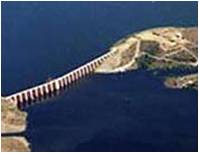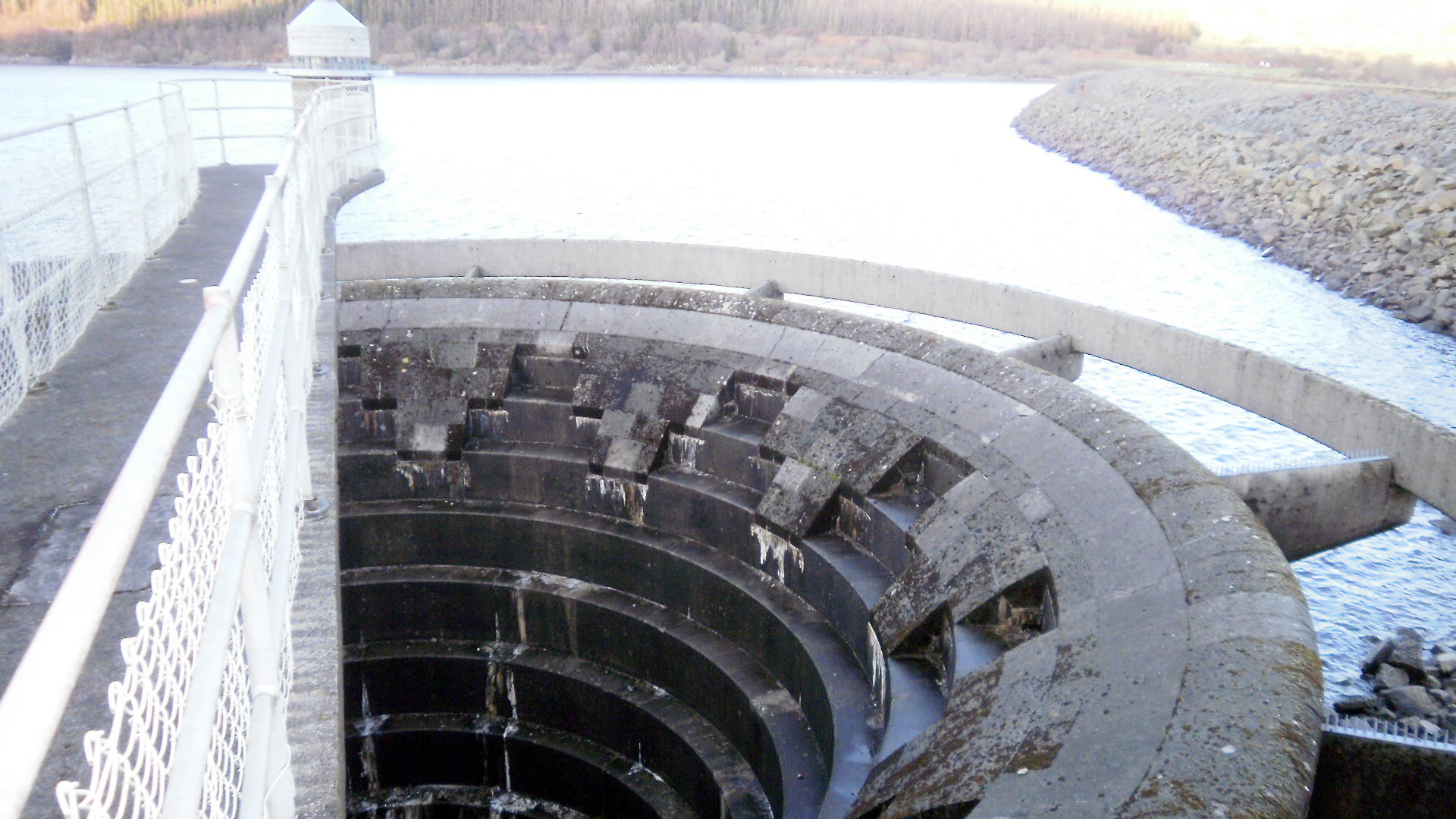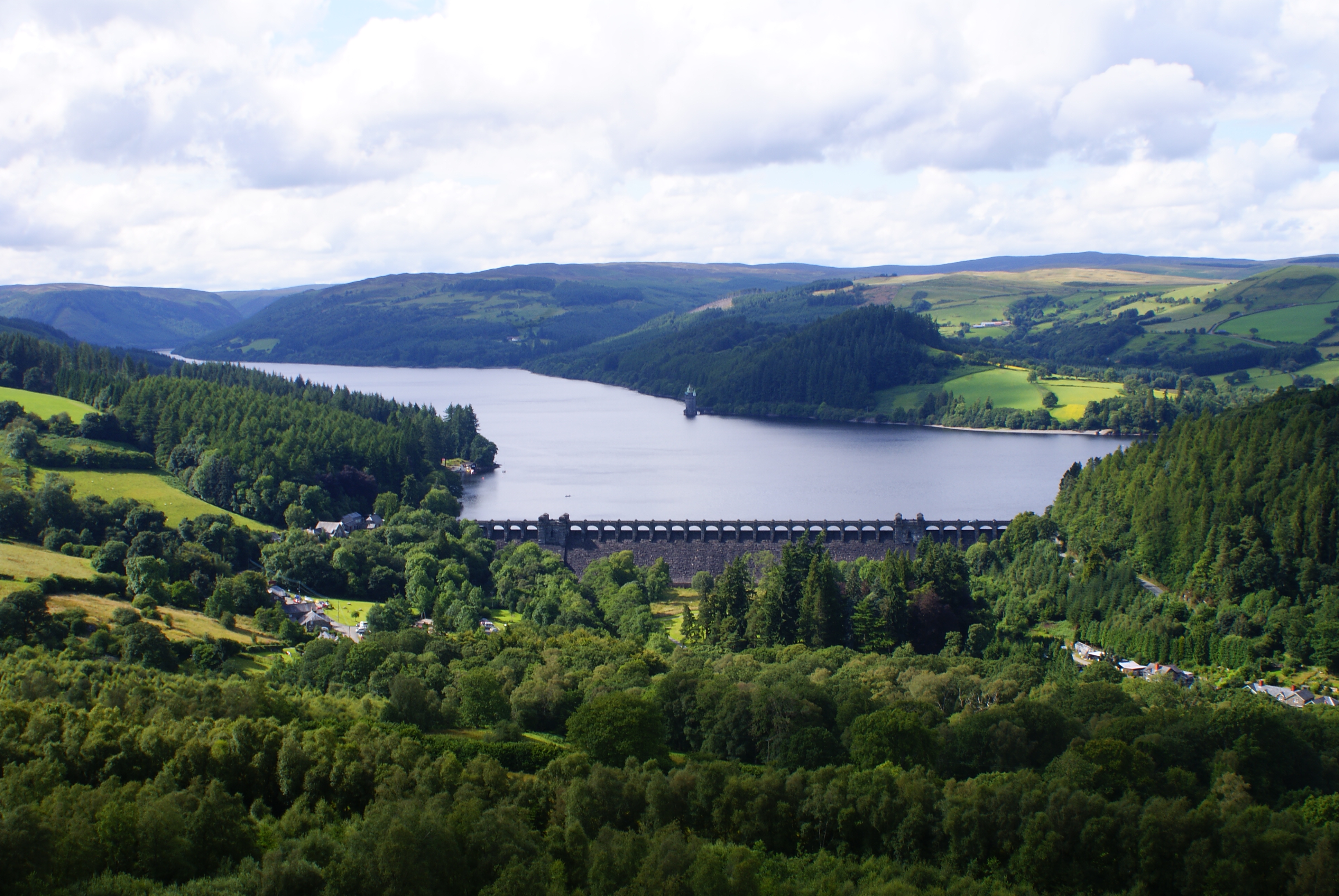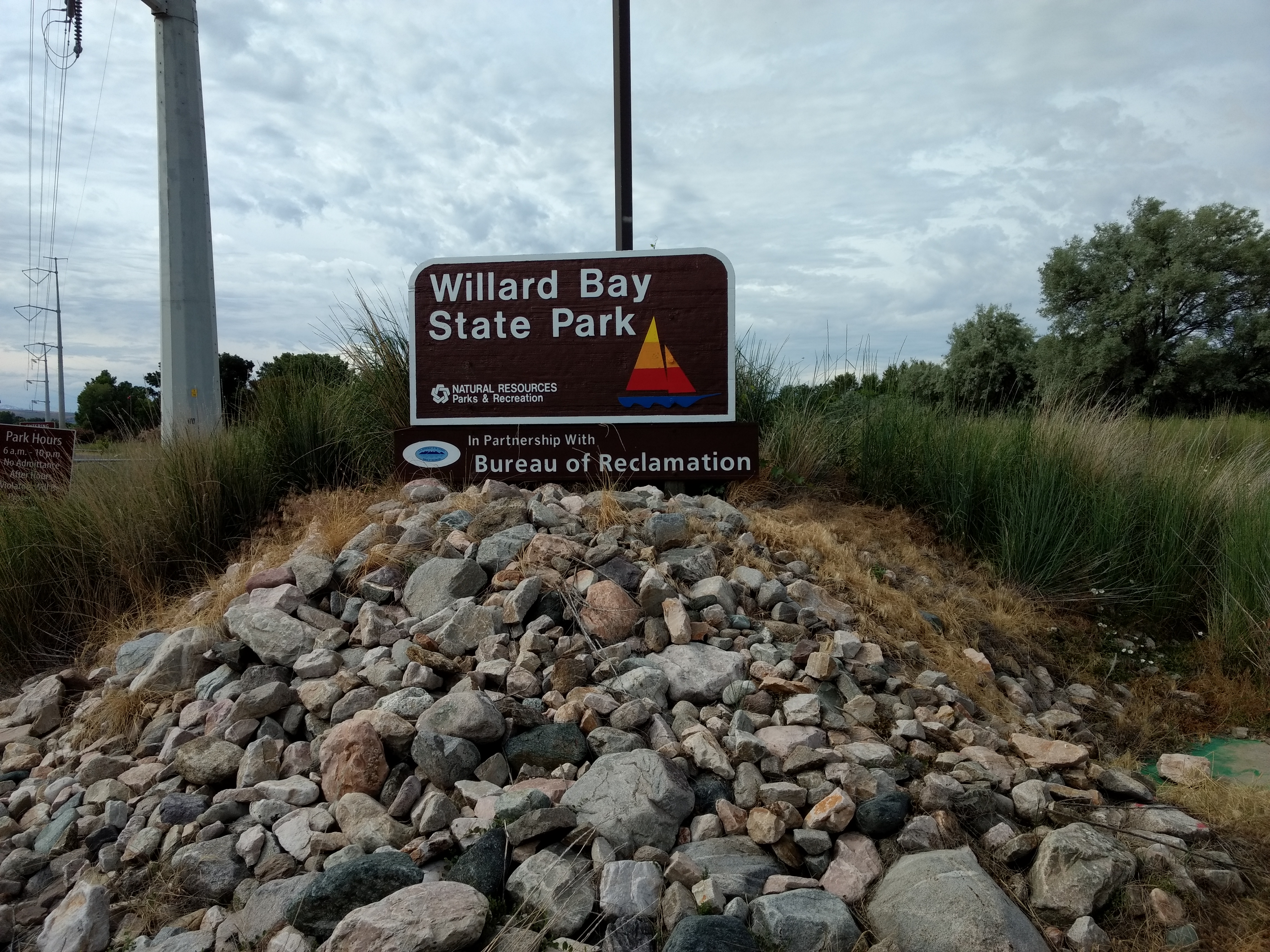|
New Waddell Dam
The New Waddell Dam is an embankment dam on the Agua Fria River in Maricopa County, Arizona, northwest of Phoenix. It serves as part of the Central Arizona Project (CAP) while also providing water for the Maricopa Water District. The dam creates Lake Pleasant with water from the Agua Fria and also the CAP aqueduct. In addition, it affords flood protection, hydroelectric power production and recreational opportunities. Construction on the dam began in 1985 and ended in 1994. Its reservoir submerged the Old Waddell Dam which was completed in 1927 after decades of planning. History Old Waddell Dam First referred to as the Frogs Tank Dam, the original Waddell Dam was the ambition of local businessmen who wanted to develop a project that used the Agua Fria for the irrigation of around of land. This was to be accomplished with a storage dam, diversion dam and system of canals. Their advancement of the project began in 1888 with the formation of the Agua Fria Water and Land Company. ... [...More Info...] [...Related Items...] OR: [Wikipedia] [Google] [Baidu] |
Maricopa County
Maricopa County is in the south-central part of the U.S. state of Arizona. As of the 2020 census, the population was 4,420,568, making it the state's most populous county, and the fourth-most populous in the United States. It contains about 62% of Arizona's population, making Arizona one of the most centralized states in the nation. The county seat is Phoenix, the state capital and fifth-most populous city in the United States. Maricopa County is the central county of the Phoenix- Mesa-Chandler, AZ Metropolitan Statistical Area. The Office of Management and Budget renamed the metropolitan area in September 2018. Previously, it was the Phoenix-Mesa-Glendale metropolitan area, and in 2000, that was changed to Phoenix-Mesa-Scottsdale. Maricopa County was named after the Maricopa Native Americans. Five Native American Reservations are located in the county. The largest are the Salt River Pima-Maricopa Indian Community (east of Scottsdale) and the Gila River Indian Comm ... [...More Info...] [...Related Items...] OR: [Wikipedia] [Google] [Baidu] |
Hooker Dam
Hooker Dam was a proposed dam on the Gila River in New Mexico, planned as a major component of the Central Arizona Project. Located near the mouth of the river's canyon upstream from the confluence of the Gila with Mogollon Creek and below Turkey Creek, the dam was to be part of the CAP's Gila River Division, authorized under the 1968 Colorado River Basin Project Act. The project was planned to provide /year of water to western New Mexico. Hooker Dam was to be located in Gila National Forest near the boundary of the Gila Wilderness. The proposed reservoir would have extended into the Gila Wilderness. Opposition to the dam came from The Wilderness Society and the Sierra Club, as well as from Arizona, which did not wish for New Mexico to retain the waters of the Gila. The enabling legislation included the phrase "Hooker Dam or a suitable alternative" to pacify conservationists who objected to the project. Acting on a report from the Carter Administration, Congress deleted funding ... [...More Info...] [...Related Items...] OR: [Wikipedia] [Google] [Baidu] |
Fuse Plug
A fuse plug is a collapsible dam installed on spillways in dams to increase the dam's capacity. The principle behind the fuse plug is that the majority of water that overflows a dam's spillway can be safely dammed except in high flood conditions. The fuse plug may be a sand-filled container, a steel structure or a concrete block. Under normal flow conditions the water will spill over the fuse plug and down the spillway. In high flood conditions, where the water velocity may be so high that the dam itself may be put in danger, the fuse plug simply washes away, and the flood waters safely spill over the dam. Fuse plugs are used in many dams throughout the world, including at Warragamba Dam in New South Wales ) , nickname = , image_map = New South Wales in Australia.svg , map_caption = Location of New South Wales in AustraliaCoordinates: , subdivision_type = Country , subdivision_name = Australia , established_title = Before federation , es .... Its fuse plugs are ... [...More Info...] [...Related Items...] OR: [Wikipedia] [Google] [Baidu] |
Spillway
A spillway is a structure used to provide the controlled release of water downstream from a dam or levee, typically into the riverbed of the dammed river itself. In the United Kingdom, they may be known as overflow channels. Spillways ensure that water does not damage parts of the structure not designed to convey water. Spillways can include floodgates and fuse plugs to regulate water flow and reservoir level. Such features enable a spillway to regulate downstream flow—by releasing water in a controlled manner before the reservoir is full, operators can prevent an unacceptably large release later. Other uses of the term "spillway" include bypasses of dams and outlets of channels used during high water, and outlet channels carved through natural dams such as moraines. Water normally flows over a spillway only during flood periods, when the reservoir has reached its capacity and water continues entering faster than it can be released. In contrast, an intake tower is a stru ... [...More Info...] [...Related Items...] OR: [Wikipedia] [Google] [Baidu] |
Drainage Area
A drainage basin is an area of land where all flowing surface water converges to a single point, such as a river mouth, or flows into another body of water, such as a lake or ocean. A basin is separated from adjacent basins by a perimeter, the ''drainage divide'', made up of a succession of elevated features, such as ridges and hills. A basin may consist of smaller basins that merge at river confluences, forming a hierarchical pattern. Other terms for a drainage basin are catchment area, catchment basin, drainage area, river basin, water basin, and impluvium. In North America, they are commonly called a watershed, though in other English-speaking places, "watershed" is used only in its original sense, that of a drainage divide. In a closed drainage basin, or endorheic basin, the water converges to a single point inside the basin, known as a sink, which may be a permanent lake, a dry lake, or a point where surface water is lost underground. Drainage basins are similar but n ... [...More Info...] [...Related Items...] OR: [Wikipedia] [Google] [Baidu] |
Reservoir
A reservoir (; from French ''réservoir'' ) is an enlarged lake behind a dam. Such a dam may be either artificial, built to store fresh water or it may be a natural formation. Reservoirs can be created in a number of ways, including controlling a watercourse that drains an existing body of water, interrupting a watercourse to form an embayment within it, through excavation, or building any number of retaining walls or levees. In other contexts, "reservoirs" may refer to storage spaces for various fluids; they may hold liquids or gasses, including hydrocarbons. ''Tank reservoirs'' store these in ground-level, elevated, or buried tanks. Tank reservoirs for water are also called cisterns. Most underground reservoirs are used to store liquids, principally either water or petroleum. Types Dammed valleys Dammed reservoirs are artificial lakes created and controlled by a dam constructed across a valley, and rely on the natural topography to provide most of the basin ... [...More Info...] [...Related Items...] OR: [Wikipedia] [Google] [Baidu] |
New Wadell Dam Aerial
New is an adjective referring to something recently made, discovered, or created. New or NEW may refer to: Music * New, singer of K-pop group The Boyz Albums and EPs * ''New'' (album), by Paul McCartney, 2013 * ''New'' (EP), by Regurgitator, 1995 Songs * "New" (Daya song), 2017 * "New" (Paul McCartney song), 2013 * "New" (No Doubt song), 1999 *"new", by Loona from '' Yves'', 2017 *"The New", by Interpol from '' Turn On the Bright Lights'', 2002 Acronyms * Net economic welfare, a proposed macroeconomic indicator * Net explosive weight, also known as net explosive quantity * Network of enlightened Women, a conservative university women's organization * Next Entertainment World, a South Korean film distribution company Identification codes * Nepal Bhasa language ISO 639 language code * New Century Financial Corporation (NYSE stock abbreviation) * Northeast Wrestling, a professional wrestling promotion in the northeastern United States Transport * New Orleans Lakefront Ai ... [...More Info...] [...Related Items...] OR: [Wikipedia] [Google] [Baidu] |
James G
James is a common English language surname and given name: *James (name), the typically masculine first name James * James (surname), various people with the last name James James or James City may also refer to: People * King James (other), various kings named James * Saint James (other) * James (musician) * James, brother of Jesus Places Canada * James Bay, a large body of water * James, Ontario United Kingdom * James College, a college of the University of York United States * James, Georgia, an unincorporated community * James, Iowa, an unincorporated community * James City, North Carolina * James City County, Virginia ** James City (Virginia Company) ** James City Shire * James City, Pennsylvania * St. James City, Florida Arts, entertainment, and media * ''James'' (2005 film), a Bollywood film * ''James'' (2008 film), an Irish short film * ''James'' (2022 film), an Indian Kannada-language film * James the Red Engine, a character in ''Tho ... [...More Info...] [...Related Items...] OR: [Wikipedia] [Google] [Baidu] |
Verde River
The Verde River (Yavapai: Haka'he:la) is a major tributary of the Salt River in the U.S. state of Arizona. It is about long and carries a mean flow of at its mouth. It is one of the largest perennial streams in Arizona. Description The river begins below the dam at Sullivan Lake, fed by Big Chino Wash and Williamson Valley Wash in Yavapai County. The Verde flows freely for through private, state, tribal and United States Forest Service lands, specifically the Tonto National Forest, before encountering the first of two dams that make Horseshoe Lake and Bartlett Lake. The cities of Camp Verde, Clarkdale and Cottonwood are the main population centers along the river. The Verde River and the Salt River confluence on the Salt River Pima-Maricopa Indian Community. The Salt River flows into the Gila River west of Phoenix. In 1984, the United States Congress designated of the Verde River as Wild and Scenic through the National Wild and Scenic River program. The Scenic port ... [...More Info...] [...Related Items...] OR: [Wikipedia] [Google] [Baidu] |
Roosevelt Dam
Theodore Roosevelt Dam is a dam on the Salt River located northeast of Phoenix, Arizona. The dam is high and forms Theodore Roosevelt Lake as it impounds the Salt River. Originally built between 1905 and 1911, the dam was renovated and expanded in 1989–1996. The dam is named after President Theodore Roosevelt. Serving mainly for irrigation, water supply, and flood control, the dam also has a hydroelectric generating capacity of 36 megawatts. History In 1888, Billy Breakenridge became surveyor for Maricopa County. He surveyed the Salt River for potential dam sites and in July 1889, he traveled with James McClintock, William J. Murphy, and John R. Norton to choose the best location. After a week on horseback, they reached Box Canyon, near the confluence of Tonto Creek and the Salt River. They recommended the location as the best site for a dam. One of the original five federal projects authorized on March 14, 1903, under the Newlands Reclamation Act of 1902, Roosevelt Dam ... [...More Info...] [...Related Items...] OR: [Wikipedia] [Google] [Baidu] |
Stewart Mountain Dam
The Stewart Mountain Dam is a concrete thin arch dam located 41 miles northeast of Phoenix, Arizona. The dam is long, high, and was built between 1928 and 1930. The dam includes a 13,000 kilowatt (kW) hydroelectric generating unit that is operated by SRP (Salt River Project), an Arizona public utility. It is primarily operated during the summer months. The dam forms Saguaro Lake as it slows the passage of the Salt River in Maricopa County, Arizona. It was named after a ranch that used to be located nearby known as the Old Stewart Ranch. A camp was built just below the dam in 1927 to house the construction workers; after the damn's completion it was turned into the Saguaro Lake Guest Ranch. The dam was listed on the National Register of Historic Places The National Register of Historic Places (NRHP) is the United States federal government's official list of districts, sites, buildings, structures and objects deemed worthy of preservation for their historical signific ... [...More Info...] [...Related Items...] OR: [Wikipedia] [Google] [Baidu] |
Bureau Of Reclamation
The Bureau of Reclamation, and formerly the United States Reclamation Service, is a federal agency under the U.S. Department of the Interior, which oversees water resource management, specifically as it applies to the oversight and operation of the diversion, delivery, and storage projects that it has built throughout the western United States for irrigation, water supply, and attendant hydroelectric power generation. Currently the Bureau of Reclamation is the largest wholesaler of water in the country, bringing water to more than 31 million people, and providing one in five Western farmers with irrigation water for 10 million acres of farmland, which produce 60% of the nation's vegetables and 25% of its fruits and nuts. The Bureau of Reclamation is also the second largest producer of hydroelectric power in the western United States. On June 17, 1902, in accordance with the Reclamation Act, Secretary of the Interior Ethan Allen Hitchcock established the U.S. Reclamat ... [...More Info...] [...Related Items...] OR: [Wikipedia] [Google] [Baidu] |




